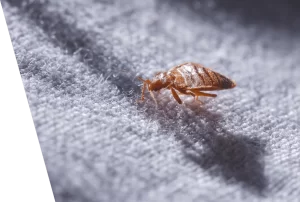 The mere utterance of bed bugs is enough to send shivers down anyone’s spine. These insects that suck blood have experienced an unwelcome return in recent years, causing chaos both at home and in hotels. Nevertheless, did it ever occur to you how these tiny terrors manage to spread with such ease? Their incredible capacity for hitchhiking holds the answer as their secret weapon.
The mere utterance of bed bugs is enough to send shivers down anyone’s spine. These insects that suck blood have experienced an unwelcome return in recent years, causing chaos both at home and in hotels. Nevertheless, did it ever occur to you how these tiny terrors manage to spread with such ease? Their incredible capacity for hitchhiking holds the answer as their secret weapon.
With their exceptional ability to blend in, bed bugs can effortlessly sneak onto unwary travellers’ clothes, luggage or furniture. These wily insects expertly jump from one host to another- whether you’re just popping over a friend’s place across the city or voyaging countrywide. In addition, these tenacious creatures are highly adaptable and show no preference when it comes to favoured habitats – they flourish alike in urban landscapes as well as rural towns because of their remarkable resilience skills.
Come along with us as we discover the secrets behind bed bug migration and conduct. We will reveal their cunning tactics for infiltrating unfamiliar territories and offer tips on safeguarding yourself against becoming their next victim.
How Bed Bugs Hitchhike
Bed bugs are expert hitchhikers that can cleverly infiltrate your personal items without detection. Their streamlined, oblong physique enables them to seamlessly slip through narrow openings such as luggage zippers and clothing creases. They do not discriminate when it comes to transportation either, readily latching onto various objects, including knapsacks, handbags, pre-owned furnishings and even electronic devices.
Bed bugs are commonly found in hotels, hostels and other types of lodging where they can quickly transfer from one guest’s belongings to another due to high turnover rates. Public transportation such as buses, trains and aeroplanes also provide a suitable mode of travel for these pests by crawling onto unsuspecting passengers and luggage.
It’s not only travelling that exposes you to risk, as secondhand furniture such as sofas and mattresses may contain bed bugs eagerly anticipating a new host. Ordinary objects like books or electronics can also unknowingly transport these pests. It’s crucial to bear in mind that bed bugs are resourceful travellers, constantly seeking out novel locations to settle down in.
Bed Bug Behavior in Urban vs. Rural Environments
 Despite their small size, bed bugs have a significant impact on various environments. In bustling urban areas such as high-rise apartments and crowded public spaces, these pests thrive due to the constant movement of people and belongings, which creates an ideal environment for them to spread quickly. Multi-unit buildings that feature shared walls and common areas are especially susceptible to infestations.
Despite their small size, bed bugs have a significant impact on various environments. In bustling urban areas such as high-rise apartments and crowded public spaces, these pests thrive due to the constant movement of people and belongings, which creates an ideal environment for them to spread quickly. Multi-unit buildings that feature shared walls and common areas are especially susceptible to infestations.
Don’t assume that rural areas are safe from persistent bed bugs. These resilient pests can invade anywhere, including peaceful farmhouses and city apartments, with equal ease. Although the spread of bed bugs in countryside regions may be slower, lack of knowledge and limited availability of specialised pest control services make it harder to deal with infestations effectively.
What are the underlying factors that affect bed bug populations in distinct settings? In metropolitan regions, high host quantities and close-packed living arrangements support the swift proliferation of these insects. Furthermore, frequent influxes of travellers facilitate their interstate transportation. Conversely, rural areas with fewer people and slower lifestyles suppress infestation rates; nonetheless, once one occurs, it can be more challenging to control due to limited resources and knowledge about how to manage bed bugs effectively.
Bed Bug Survival
Bed bugs pose a significant challenge to extermination due to their exceptional capacity for survival during prolonged periods without blood sustenance. These tough insects usually prefer consistent feeding, but in times of scarcity, they can enter hibernation mode. Astonishingly, research indicates that bed bugs have the ability to persist without nourishment for several months while waiting patiently until another chance arises to feed on human hosts again.
The ability to lie dormant is an essential component of the bed bug’s capacity to propagate extensively. Bed bugs can sustain themselves for extended periods in empty suitcases or deserted dwellings, resurfacing only when a fresh host appears and initiating another infestation cycle. Their propensity for concealment also makes locating and eradicating them tricky since they are capable of ensconcing themselves within crevices and fissures, evading detection while biding their time.
Bed bugs are able to survive extended periods without food by significantly slowing their metabolism and reducing activity. This allows them to preserve energy and subsist on stored nutrients until a fresh blood supply becomes attainable. Although this survival tactic is remarkable, it underscores the need for watchfulness and preventative actions in order to avoid unwittingly introducing these tenacious pests into your living space.
Preventing Bed Bug Transportation During Travel
Although travelling can be an exciting adventure, it’s crucial to stay vigilant about possible exposure to bed bugs. These irritating pests might effortlessly infiltrate your possessions or bags and return with you home. Nevertheless, adopting a handful of easy measures would enable you to reduce the likelihood that these unwanted mementoes will accompany you on your journey back home.
When checking into a hotel or other lodging, make sure you take a close look around the room before unpacking. Make sure you thoroughly inspect every location for indications of a bed bug infestation, such as live insects, shed skins, eggs, or faeces, including headboards, surrounding furniture, and seams on mattresses. Should evidence suggest the presence of these pests in your accommodation, kindly notify hotel personnel promptly and request an alternative arrangement without delay.
When packing your belongings, choose hard-shell suitcases, as they are more resistant to bed bug infestations. Whenever possible, use luggage racks that keep the bags off floors or beds. To further prevent bed bugs from infiltrating your clothes, refrain from scattering items around and instead store them securely in either vacuum-sealed plastic bags or designated laundry facilities provided by hotels for their patrons’ convenience.
Upon arriving home, promptly put your luggage in the washing machine and use high temperature to launder all garments. This will eradicate any potential bed bugs. Be sure to vacuum thoroughly by concentrating on seams and crevices, then dispose of the bag immediately after usage. By following these preventive measures, you can reduce the risk of bringing bed bugs into your household while travelling.
Preventing Bed Bug Transportation in Daily Life
 Although travelling is a typical method for acquiring bed bugs, these parasites can also invade your daily routines. Everyday errands such as visiting the library or catching public transport pose a risk of encountering them. Additionally, secondhand furniture and clothing are well-known culprits for hosting bed bugs.
Although travelling is a typical method for acquiring bed bugs, these parasites can also invade your daily routines. Everyday errands such as visiting the library or catching public transport pose a risk of encountering them. Additionally, secondhand furniture and clothing are well-known culprits for hosting bed bugs.
To ensure your safety, it is essential to be aware of where you place your personal items when in public areas. Refrain from placing bags or purses on floors, especially ones with high foot traffic. If using public transportation, make sure to avoid contact with seats or walls where bed bugs may potentially reside.
When patronising thrift stores or engaging in secondhand shopping, it is prudent to meticulously examine items before taking them home. Check for indications of bed bugs within the seams, folds and crevices. If feasible, launder any previously owned clothing with hot water and then tumble dry it on high heat prior to donning it.
It’s crucial to exercise caution when inviting people over to your place. If you’re aware someone has battled a bed bug outbreak, request they take measures beforehand, such as cleansing their clothing and possessions in high-temperature water. By being mindful of everyday threats like this one, you can significantly reduce the possibility of these bloodsuckers unwittingly accompanying folks into your living space.
If you have any doubt that you have been in touch with someone who suffers from an infestation or that such a person has visited your place, contact bed bug treatment specialists as soon as possible.
Conclusion
Although small, bed bugs are incredibly resilient and adaptable to new environments. It is crucial to comprehend how these pests spread in order to protect yourself from unwanted infestations both at home and while travelling. By diligently inspecting secondhand items before bringing them into your space, practising cautious travel habits, as well as taking the necessary precautions when in public areas, you can noticeably decrease the likelihood of encountering bed bugs. Remember that prevention plays a vital role in deterring these persistent critters from invading your sanctuary – staying informed and implementing proactive measures will provide peace of mind, knowing that you have taken all possible steps towards maintaining a sanitary living environment free from any potential threat posed by pesky bedbugs!
Worried about bed bugs in your home or belongings?? Get help here: https://www.fantasticservices.com/bed-bug-heat-treatment/














